
CodeNotes: Rehabilitation of Building Sewers and Building Drains in the I-Codes
Addressing the code requirements in section 718 of the 2021 International Plumbing Code.
This edition of CodeNotes — Rehabilitation of Building Sewers and Building Drains in the I-Codes — is based on Section 718 of the 2021 International Plumbing Code®
Introduction
The 2021 International Plumbing Code® (IPC) recognizes various available technologies for the relining of existing building sewer and building drainage piping while also providing the necessary inspection procedures that ensure a safe and efficient pipe lining installation. Section 718 of the IPC covers a process referred to as the “cured in place pipe” (CIPP) method of pipe rehabilitation for relining of building sewers and drains. This CodeNote covers the CIPP process, which involves inserting a felt tube into a flexible calibration tube (for insuring the final cured pipe). The felt tube is impregnated in the field with polyester resin typically used for mainline lining or epoxy resin for lateral lines. The tube assembly is inverted as it is inserted or pulled into the cleaned existing pipe to place the calibration tube on the inside of the felt liner. The calibration tube is expanded, and heat or ultraviolet light is used to dry and harden the liner inside the pipe. The liner essentially forms a smooth surface inside the existing pipe, restoring it to a near-new condition. The calibration tube is removed after curing is complete.
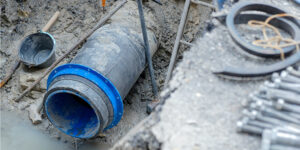
Section 718 Rehabilitation of Building Sewers and Building Drains
Section 718.1 Cure-in-place
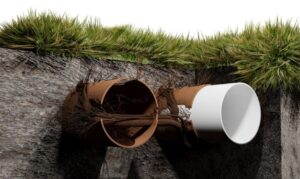
Before and After (Picture provided by Waterline Renewal Technologies)Sectional cure-in-place rehabilitation of building sewer piping and sewer service lateral piping shall be in accordance with ASTM F2599. Main and lateral cure-in place rehabilitation of building sewer and sewer service lateral pipe and their connection to the main sewer pipe shall be in accordance with ASTM F2561. Hydrophilic rings or gaskets in cure-in place rehabilitation of building sewer piping and sewer service laterals shall be in accordance with ASTM F3240 to ensure water tightness and elimination of groundwater penetration.
Summary of Referenced Standards
Sectional repairs shall comply with ASTM F2599 which is limited to the requirements and test methods for the sectional cured-in place lining (SCIPL) repair of a pipeline (4 in, through 60 in. (10.2 cm-152 cm) in diameter. The finished SCIPL shall be continuous over the entire length of the rehabilitated section of pipe. SCIPL shall be free of dry spots, lifts, and delamination. The cured liner shall taper at each end to accept video equipment and maintain a proper flow. Main sewers and service laterals must comply with ASTM F2561, which addresses service lateral pipe with an inner diameter of 3 to 12 in. (7.6 to 30.5 cm) and is permitted to connect to sewer mains with an inner diameter of between 6 and 24 in. (15.2 to 61.0 cm) and up the lateral a maximum of 150 ft. without excavation.
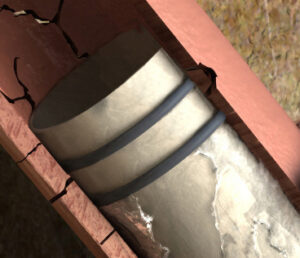
ASTM F3240 covers the requirements for the installation of seamless molded hydrophilic gaskets (SMHG) in CIPP rehabilitation of main and lateral pipelines. Due to the possibility that the CIPP liners could shrink during polymerization resulting in an annular space between the liner and the host, a hydrophilic O-ring shall be positioned between the liner tube and the host pipe producing a compression gasket seal that is compatible with all piping materials ensuring a watertight seal. The O-Ring is designed to attach to a liner tube near the terminating end of a liner that is either inverted or pulled into place to form a robust seal.
A molded neoprene expansion gasket consisting of a tubular portion and a brim portion referred to as a connection seal when positioned at the connection of the lateral pipe and the main pipe will form a robust seal between a main pipe or a main liner and a lateral liner.
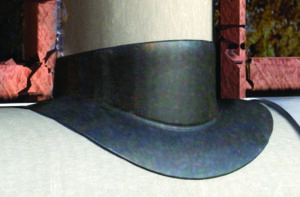
The end seal sleeve is positioned at the upstream and downstream ends of a main pipe section typically 6 in. from a manhole connection prior to the main liner installation. The end seal sleeve is held in place by a mechanical fastener. For larger diameter pipe (diameter 18 in. and larger), the sleeve and its fastener are held in place by anchor screws.
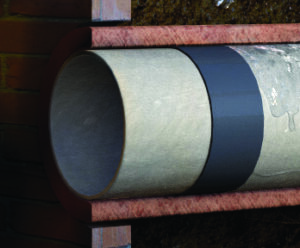
Note: Designers and specifiers, regulatory agencies, owners and inspection organizations who need additional information on the installation of this pipe rehabilitation method should obtain copies of the reference standards noted in Section 718 “Rehabilitation of Building Sewers and Building Drains”.
The I-Codes continue to provide sustainable solutions to assist building owners, designers, inspectors, municipalities, and contractors involved in the replacement of underground building sewers and building drains.
To Order the 2021 IPC or IRC, Commentaries or other support references, visit shop.iccsafe.org.







